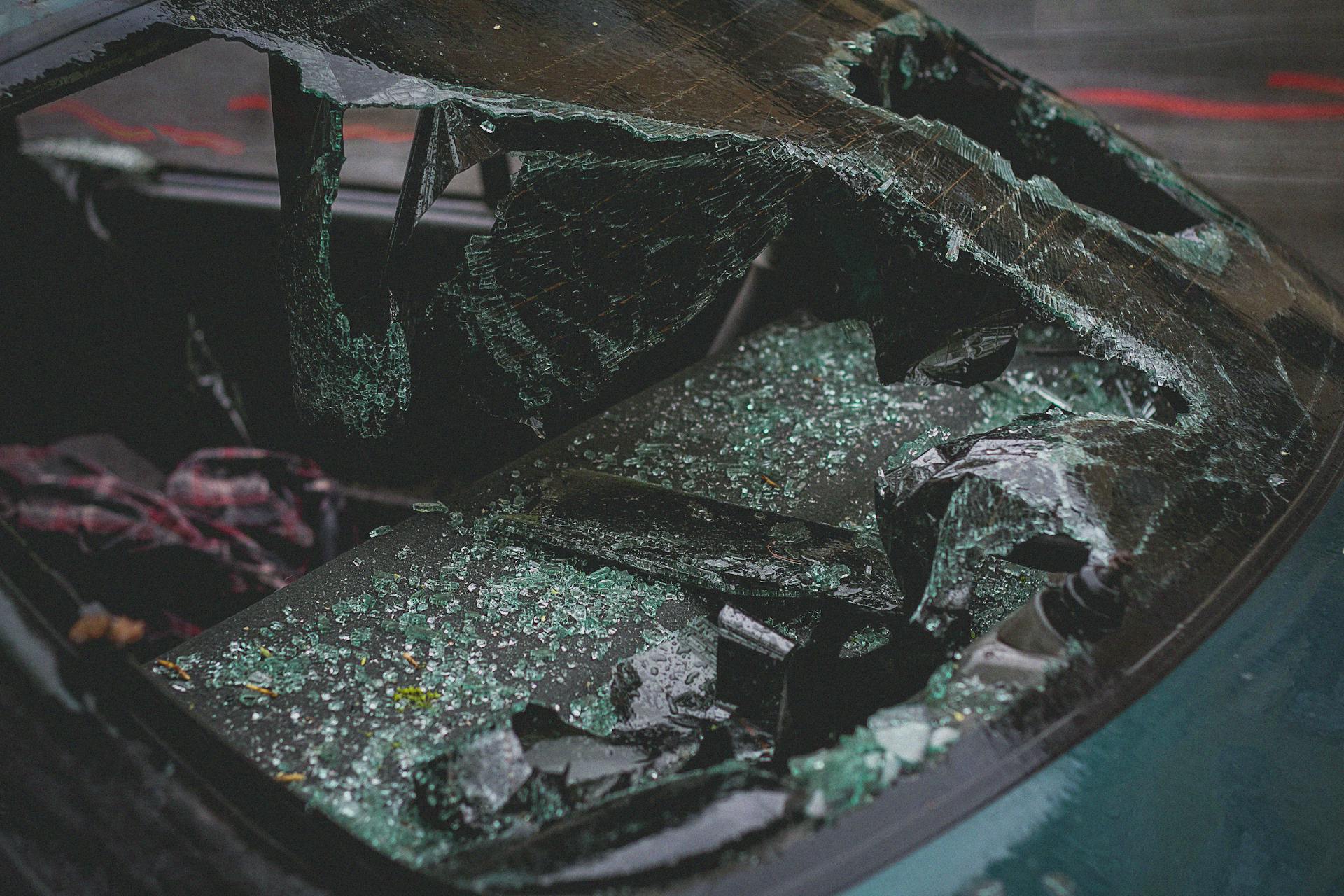
No fault auto insurance states have unique laws that govern how claims are handled. These states typically don't require drivers to prove fault in order to file a claim.
In Michigan, for example, drivers can file claims without proving fault, but they can also sue for non-economic damages if they can prove the other driver was at fault. This is a key difference between Michigan and other no fault states.
Drivers in no fault states often pay higher premiums, but they also have more protection in case of an accident. In New York, for instance, drivers can recover up to $50,000 in medical expenses, regardless of who was at fault.
No fault insurance can be complex, so it's essential to understand the laws and regulations in your state.
Readers also liked: Do Insurance Companies Sue Uninsured Drivers
How No-Fault Auto Insurance Works
In no-fault states, personal injury protection insurance pays out immediately, regardless of who is responsible for the car accident. This is a key feature of no-fault insurance.
Take a look at this: What Is No Fault Insurance

The primary purpose of no-fault insurance is to save money and time, often involved in lawsuits. Claims processes and lawsuits usually cause high expenses for both parties and delay the settlement.
In no-fault states, the likelihood of one party suing the other is lower. This is because personal injury protection insurance pays out immediately, eliminating the need for a lengthy and costly lawsuit.
No-fault states aim to simplify the claims process, reduce litigation costs, and provide quick payments. This is why it's called no-fault, as the insurance system does not require the determination of fault before paying for the losses.
Here's a comparison of the key differences between no-fault and at-fault states:
By mandating PIP, no-fault states aim to reduce the reliance on the court system to resolve accident claims, thereby decreasing legal fees, court costs, and the duration of disputes.
Key Considerations for No-Fault States
In no-fault states, drivers are required to have personal injury protection coverage as part of their auto insurance policy. This coverage helps pay for medical bills and other expenses related to an accident.
Explore further: Commercial Property Insurance Coverage Questions

To navigate no-fault states, it's essential to know the specific rules and regulations in your state. Research online and ask insurance providers to confirm the type of no-fault insurance your state follows. In some states, like Kentucky, New Jersey, and Pennsylvania, you may have the option to choose between a no-fault policy and a traditional tort policy.
If you live in a no-fault state, understand the threshold conditions that determine the severity of injuries and the right to sue. In no-fault states, the other driver is still responsible for paying for damage to your car, assuming they caused the accident.
For your interest: Insurance Cover on Business - Merchant Services
Living in a State: Key Considerations
If you live in a no-fault state, it's essential to know what variation of no-fault your state follows. This can be researched online or confirmed by asking insurance providers in your state.
In some states, like Kentucky, New Jersey, and Pennsylvania, you have the option to choose between a no-fault policy and a traditional tort policy. This selection can be made when you get your insurance policy.

If you live in a state with mandatory no-fault insurance, like Puerto Rico, you'll need to ensure you have the required minimum amount of Personal Injury Protection (PIP) coverage. This coverage typically includes medical bills, out-of-pocket expenses, lost wages, and funeral expenses.
In no-fault states, the minimum PIP coverage levels required for motorists are determined by the state. For example, Florida requires $10,000 worth of Personal Injury Protection (PIP) and $10,000 of Property Damage Liability (PDL).
To make informed decisions about your insurance coverage, it's crucial to understand the specific requirements and limitations in your state.
Broaden your view: Health Insurance Asking about Accident or Injury
Auto Cost
Auto costs in no-fault states can be significantly higher than in traditional liability insurance states. This is largely due to the fact that claims are paid regardless of fault, which can lead to increased costs for insurance companies.
In no-fault states, claims are paid out regardless of who is at fault in an accident. This can result in higher insurance costs.

Some of the reasons for higher insurance costs in no-fault states include encouraging more incidents of fraud, possible exaggerated injuries, and repeat offenders. These factors can all contribute to increased costs for insurance companies.
Here are some key factors to consider when it comes to auto costs in no-fault states:
Determining Fault and Liability
Determining fault and liability can be a complex process, but it's essential to understand how it works in no-fault states. In these states, the driver's personal injury protection (PIP) coverage pays out for lost wages and medical expenses, regardless of fault.
Insurance companies will consider all the evidence available, such as police reports, witness statements, and photos of the damage to the vehicles. They'll also take into account the laws of the state where the accident occurred.
There are only 12 U.S. states that require no-fault insurance, and drivers in these states still carry liability insurance to cover expenses they cause to others if they're at fault. Here are the no-fault states: New York New Jersey FloridaHawaii Kansas Kentucky North DakotaPennsylvaniaMassachusettsMichiganMinnesotaUtah
Readers also liked: Non Profit Business Insurance
Types of Negligence
Negligence can take many forms, and understanding the different types can help you navigate complex liability situations.
The first type of negligence is failing to act as a reasonable person would in the same situation. For example, speeding on a rainy day and causing a crash.
This type of negligence is often the most straightforward to prove, as it involves a clear failure to meet a basic standard of care.
The second type of negligence is acting with extreme disregard for the safety or rights of others. For instance, a doctor performing surgery while intoxicated and causing the patient to die.
This type of negligence is typically considered more severe than the first type, as it involves a reckless disregard for human life.
In some cases, both parties may be partially at fault for the harm or damage that occurred. This is known as comparative negligence.
For example, if a driver runs a red light and hits another driver who was speeding, both drivers are guilty of comparative negligence.
Determining Fault in Companies
Determining fault in an accident is a crucial step in the claims process. Insurance companies will look at all the evidence available.
The police report is a key piece of evidence that insurance companies rely on. They'll review it carefully to understand what happened.
Witness statements are also taken into account. Insurance companies will consider what witnesses saw and heard.
Photos of the damage to the vehicles are another important factor. They can help insurance companies piece together what happened.
Insurance companies will also consider the laws of the state where the accident occurred. This ensures that they're applying the right rules to determine fault.
A unique perspective: Will Asurion Cover Cracked Screen
Liability for Damages
In a no-fault state, the driver who caused the damage to your car still has to pay for repairs or replacement, regardless of the state's no-fault rules.
If you're the at-fault party in a car accident, personal injury protection does not cover damage to your own vehicle. You'll still need to have comprehensive or collision coverage to avoid paying out of pocket for this type of damage.
Recommended read: Accidental Damage Buildings Insurance
Insurance companies will look at all the evidence available, such as the police report, witness statements, and photos of the damage to the vehicles, to determine who is at fault.
The burden of proof will be on you to show that the other driver was negligent if you were the victim of a serious accident that was caused by their negligence.
You can still sue the other driver for personal injury damages, such as pain and suffering, lost wages, and medical expenses, if you can prove they were negligent.
In a fault state, the driver's property damage liability covers the car repair expenses while bodily injury liability insurance pays for the medical costs.
There are four types of negligence: failing to act as a reasonable person would in the same situation, acting with extreme disregard for the safety or rights of others, and both parties being partially at fault for the harm or damage that occurred.
Here are the 12 U.S. states that require no-fault insurance:
- New York
- New Jersey
- Florida
- Hawaii
- Kansas
- Kentucky
- North Dakota
- Pennsylvania
- Massachusetts
- Michigan
- Minnesota
- Utah
In a no-fault state, all drivers should carry Personal Injury Protection Insurance coverage, which will significantly increase auto insurance costs.
At-Fault vs No-Fault Insurance

In no-fault states, personal injury protection (PIP) coverage pays out for lost wages and medical expenses, regardless of fault.
The primary differences in coverage requirements for no-fault states include paying for medical bills using PIP coverage and determining property damages based on who is responsible in the accident.
No-fault states require PIP coverage, which can be a financial burden, even if you didn't cause the accident.
In at-fault states, the driver who caused the accident pays for the injuries and property damage of the other, using a tort liability insurance system.
Claims tend to take longer in at-fault states than in no-fault ones, as insurers have to determine fault after an accident.
There are only 12 U.S. states that require no-fault insurance, including New York, New Jersey, Florida, and Hawaii.
Here are the states that require no-fault insurance:
- New York
- New Jersey
- Florida
- Hawaii
- Kansas
- Kentucky
- North Dakota
- Pennsylvania
- Massachusetts
- Michigan
- Minnesota
- Utah
No-Fault Insurance and Damage
In a no-fault state, the law requires each driver to file a claim with their own insurance company, so all medical expenses are paid by each driver's individual insurance companies, regardless of fault.
Medical bills, out-of-pocket expenses, lost wages, and funeral expenses are typically covered by a basic insurance plan in a no-fault state.
Drivers in no-fault states should carry Personal Injury Protection Insurance coverage, which can significantly increase auto insurance costs, making insurance in no-fault states more expensive than in fault states.
Here's a breakdown of what's typically covered in a basic insurance plan in a no-fault state:
- Medical bills
- Out-of-pocket expenses
- Lost wages
- Funeral expenses
Repair Process
If you've been in an accident in a no-fault state, you'll need to file a claim with your insurance company to get your car repaired.
First, you'll need to get your car assessed by an insurance adjuster, who will determine the extent of the damage and provide a repair estimate.
You'll need to choose a repair shop that's approved by your insurance company, as they'll work directly with the insurance company to get your car fixed.
The repair shop will then provide a repair plan and timeline to the insurance company, who will review and approve the plan before work begins.
For another approach, see: Motor Insurance Business Use

Once the repair plan is approved, the repair shop will get to work on fixing your car, using the original equipment manufacturer (OEM) parts whenever possible.
After the repairs are complete, the insurance company will inspect the work to ensure it meets their standards, and then your car will be returned to you.
If this caught your attention, see: Can an Insurance Agent Work for Two Different Agencies
Who Pays for Damage?
In a no-fault state, the driver who caused the damage to your car still has to pay for repairs or replacement.
You'll need to make a claim with the at-fault driver's insurance company for the expenses. Personal injury protection does not cover damage to your own vehicle if you’re the at-fault party in a car accident.
You'll still need to have comprehensive or collision coverage to avoid paying out of pocket for this type of damage.
You'll have to pay for your own insurance deductible in an at-fault state, but not if someone else was responsible for your car's damage and you make a third-party claim with their insurance for the damage to your property.
In a no-fault state, blame is still assigned, but the main difference is who pays for the medical expenses.
Intriguing read: Not at Fault Insurance Claim
Frequently Asked Questions
What is the advantage of a no-fault system for states?
In no-fault states, the claims process is simplified as each party deals with their own insurance company, reducing the need for complex lawsuits and disputes. This streamlined process can lead to faster and more efficient resolution of claims, saving time and hassle for all parties involved.
What is no-fault insurance disadvantage?
No-fault insurance has a disadvantage in that it limits lawsuit options for drivers, requiring severe injuries to file a claim
Sources
- https://coverage.com/insurance/what-does-a-no-fault-state-mean-for-auto-insurance/
- https://www.policygenius.com/auto-insurance/states-with-no-fault-insurance/
- https://www.libertymutual.com/insurance-resources/auto/what-are-no-fault-insurance-states
- https://www.coluccio-law.com/no-fault-state/
- https://1800lionlaw.com/fault-vs-no-fault-insurance-laws-by-state/
Featured Images: pexels.com


